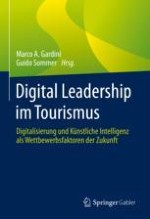2023 | OriginalPaper | Chapter
Digitalisierung von Gästekarten in Destinationen – Eine systematische Analyse auf Basis der Programmtheorie
Author : Nancy Richter
Published in: Digital Leadership im Tourismus
Publisher: Springer Fachmedien Wiesbaden
Activate our intelligent search to find suitable subject content or patents.
Select sections of text to find matching patents with Artificial Intelligence. powered by
Select sections of text to find additional relevant content using AI-assisted search. powered by
